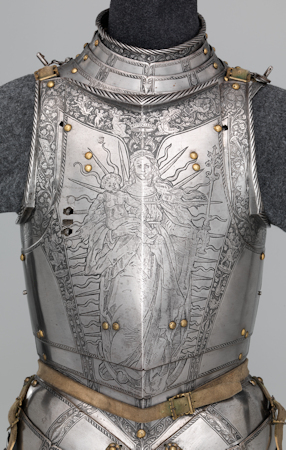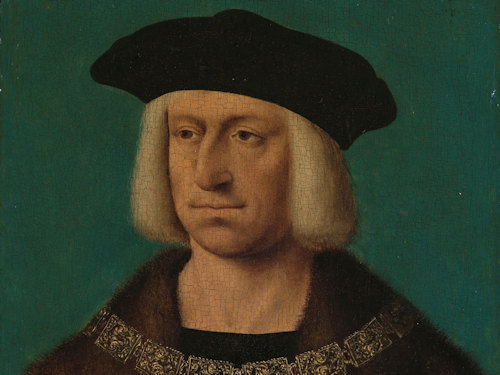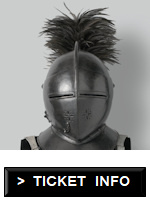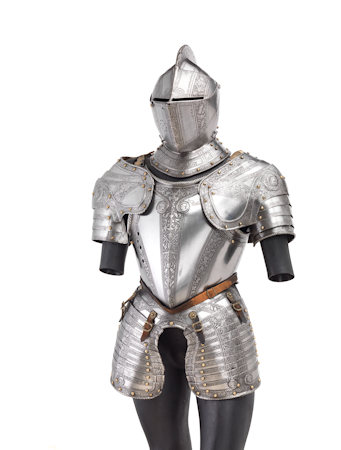Where others might get a new tie for that special occasion, the 15th, 16th and 17th-century male aristocracy got a new suit of armour. And a lot of that armour now graces the Neue Burg wing of the Hofburg as the Hofjagd und Rüstkammer (Imperial Armoury).
- Mostly ceremonial and tournament armour and weapons
- Many breathtaking items on display
- Layout and approach rather like an art museum (not an educational journey)
- Part of the Weltmuseum complex
- Book Weltmuseum tickets* online
- See also:
Arms and Armour collection
(Cuirass from Milan; Helmet; ca. 1560; Wien Museum Inv.-Nr. 127345; Reproduced with permission under the terms of the CC BY 4.0 licence; Photo by Birgit und Peter Kainz, Wien Museum. Illustrative – not on display!)
You know those mounted knights you find as toys with wooden castles? The Imperial Armoury inside the Weltmuseum complex is the grown-up version with full-scale models in the actual gear made for kings and emperors.
The armoury draws together armour and weapons from various historical imperial collections, the original items having been gathered through gifts, diplomatic exchanges, special commissions, and purchases.
A special nod of thanks and the wave of a heavily-decorated sword goes to the avid art collector and 16th-century Archduke of Austria, Ferdinand II.
The amount of armour and weapons on display is rather impressive: sweeping lines of silvered knights and horses, cabinets full of golden-hilted swords, and rows of guns with more decorative elements than a Baroque chapel ceiling.

(Decorated 16th-century breastplate made for Emperor Ferdinand I by Kunz Lochner; image courtesy of the Met Museum; illustrative and not on display)
As you examine the plates, bolts and all sorts of weird and wonderful armoured accoutrements, you might wonder how they were made.
How did the owners even get into them? And how did their design relate to their performance or impact?
Those questions aren’t really answered. Instead, think of the Imperial Armoury as more of a historical record or an art museum.
Do not expect insight into the mechanics of war or battle. What you do get, though, is a clear impression of arms and armour as a form of aristocratic marketing…as a symbol of prestige.

(Vienna’s Weltmuseum houses the Imperial Armoury)
Armour as the medieval power suit. Armour as a projection of strength, wealth, and authority. Armour as an outlet for extraordinary craftsmanship.
All the above comes across through the elegance of the metalwork and the exquisite ornamentation seen in Sauronesque gauntlets, decorated falconry hoods, ornate gun barrels and the custom sets made for the likes of Philip II of Spain or Emperor Charles V.
You can tell much of the armour is custom, because some were very clearly made for gentlemen who overindulged on the mead and venison.
Personal collection highlights

(Admire the armour made for this fine gentleman: Emperor Maximilian I (1459-1519) as painted in 1530 by the workshop of Joos van Cleve. Image courtesy of the Rijksmuseum)
Perhaps the biggest highlight is the total impression: the assemblage represents the pinnacle of craftsmanship in the 15th, 16th and 17th centuries in particular.
But here are my personal recommendations from an afternoon of browsing…
One room, in particular, forms part of the great curving inner wing of the Neue Burg, full of marbled walls and decorated arched ceilings that seem to go on endlessly.
This forms a glorious and apt location for displaying tournament knights and horses in full regalia, with plumed helmets and matching caparisons for the horses (the caparison is the cloth covering the horse. And, yes, I had to look that up).
Also look out for:
- An ornate mace with built-in chess board, sundial, and compass. Like a 15th-century smartphone.
- Extremely elegant armour for Emperor Maximilian I with remarkably long pointed sabatons (foot armour) that Rosa Klebb would have killed for
I’m guessing the Emperor never had to climb any stairs in that particular outfit.

(A hunting crossbow made in the early 1500s; press photo © Kunsthistorisches Museum Wien, Hofjagd- und Rüstkammer)
- Emperor Frederick III’s horse armour, complete with steampunk-style double-headed Habsburg eagle
- A room of “show” items, with, for example, extraordinarily-decorated armour for Henry III of France and a sword with a coral hilt
- 16th and 17th-century guns with detailed metal or bone inlays, shell-covered stocks, and locks crafted into the shape of dragons or serpents
- The tournament armour of Archduke Ferdinand II, with a plume of feathers that would drive a Las Vegas showgirl to tears of jealousy
- A set of Samurai armour from around 1700, as part of a Habsburg oriental and Islamic armour collection
- A multi-piece set of matching tournament armour for Emperor Maximilian II, so he could stay on brand whatever the particular style of combat
- The black armour illustrative of the last few years of the knight era, inevitably calling to mind the Black Knight of Monty Python’s Holy Grail fame
Tickets & visitor tips
An entrance ticket from or for the Weltmuseum gets you into the armoury.
(Booking service provided by Tiqets.com*, who I am an affiliate of)
- Almost all written exhibit information was in German on my visit, bar the occasional item tags and one or two video presentations. Audioguides to selected items are available.
- Neighbouring rooms house the historical instruments collection (also part of the same institution). Don’t mix the two up. You don’t want to fend off a rampaging armoured Ottoman using a violin bow and a small container of rosin.
- For more historical arms and armour, consider visiting the Heeresgeschichtliches (Military History) Museum (HGM)
The HGM has galleries devoted to, for example, the Thirty Years’ War and Ottoman campaigns, or the Napoleonic wars and revolutions in Europe. Not to mention the artillery halls, whose exhibits begin with medieval cannons.
- Make use of your Weltmuseum ticket to visit the excellent ethnographic collections and exhibitions. The atrium café set in remarkable interior architecture is a favoured stop in town for me and my partner
- Get in once for free with a Vienna Pass (my review)
How to get to the Imperial Armoury
The Armoury sits on the first floor of the Weltmuseum, which is actually two floors up from the entrance area and atrium.
The Weltmuseum resides in the Neue Burg building on Heldenplatz, the huge square in the city centre flanked by the president’s offices and other important locations. So you’ll probably pass through it on your sightseeing walks.
See here for public transport travel tips for the museum.
Address: Heldenplatz, 1010 Vienna | Website

